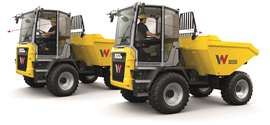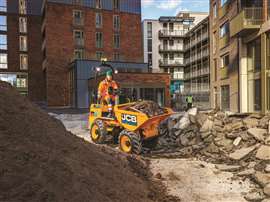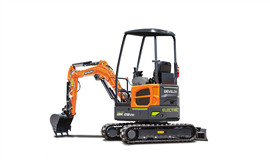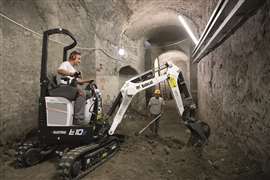How urbanisation is set to drive demand for compact machines higher
09 February 2024
Equipment manufacturers are banking on European urbanisation to drive sales of compact earthmoving machines. Mike Hayes reports.
To the untrained eye – and perhaps some trained eyes – a busy urban construction site can look like an accident waiting to happen.
When heavy machinery is on the move, in close proximity to workers and an unwary population, the question of safety has to move to another level.
This is one of the reasons we are seeing so many more compact machines operating on construction sites in cities and sensitive or urban areas.
You might think, as a consequence, productivity will be reduced, with smaller machines by nature being less powerful and having, for example, reduced earthmoving capacity.
While this is basically true, with the latest generation of compact machines, the differences are diminishing, while the benefits increase.
Smaller excavators, loaders and dumpers are rapid, agile and easily transportable. They also tend to boast much lower (increasingly zero) emissions.
Productivity gains
 A demonstration of the variable operator positions on Wacker Neuson’s dual view dumpers (Photo: Wacker Neuson)
A demonstration of the variable operator positions on Wacker Neuson’s dual view dumpers (Photo: Wacker Neuson)
German manufacturer Wacker Neuson has been operating in this space for many years, with a reputation for designing machines with inner-city applications in mind.
Andreas Gstöttenbauer, the company’s head of product management, says, “Compact machines have become increasingly productive in recent years.
Technologies that were previously only known from larger machine classes have been transferred to the compact segment and have increased productivity.”
As an example, Gstöttenbauer offers the fact that tiltrotators are now available for use on excavators starting from the 6-tonne class.
“In consequence,” he says, “smaller machines have been considered for more jobs – bringing advantages such as more manoeuvrability and a lower purchase price.”
Wacker Neuson’s dual View dumpers, first seen as a concept in 2019, are another good example of how smaller machines can match up to machines in a considerably heavier weight class.
The largest on offer from Wacker Neuson is the DV90, which, like the smaller models, has a rotating seat, allowing operators to access both sides of the machine, regardless of seat orientation, contributing to a safer and more efficient work environment.
Latest iterations of the machines, however, also boast improved efficiency and increased power. The DV90 has a payload capacity of up to 9 tonnes, plus a Power motor option providing a significant boost in tractive force and power.
From a safety perspective, the dumper has a Hill Hold function, which automatically engages the brake and prevents any backward movement.
‘Sustainable urbanisation’
Caterpillar’s Bahar Ozturk, mini excavator marketing manager for EAME echoes many of Gstöttenbauer’s sentiments, and feels Europe is set to be an important market for compact machines in the future.
 JCB’s battery-electric 1TE site dumper at work on an urban job site (Photo: JCB)
JCB’s battery-electric 1TE site dumper at work on an urban job site (Photo: JCB)
“The European Union,” she says “has identified priorities for urban development in coming years, such as climate adaptation, air quality, energy transition, sustainable use of land and nature-based solutions where compact construction equipment can work in a wide variety of applications to support these initiatives.”
Ozturk sees “sustainable urbanisation” only gaining more traction.
Cat’s first elect machines are perhaps coming to the market at the right time, with the Cat 301.9 electric mini excavator launching soon.
In the past, it’s fair to say that smaller machines have generally had to wait for some of the technological and engineering advances made by their larger counterparts to trickle down to them.
Ozturk believes that is no longer the case.
She says, “While urbanisation is increasing, the development of machines with new technology features continues. For instance, the Cat 306 CR mini excavator comes with a factory-fitted fully-integrated ease of use system that allow operators to create 2D E-fences.
“The 2D E-fence keeps the front linkage within a predefined work area to avoid hazards such as traffic. It uses data from position sensors to automatically stop motion when the front linkage reaches the defined boundaries.”
The benefits of this sort of digital technology will not be lost on companies keen to ensure their operators are refreshed and alert throughout their shifts.
The safety benefits of using technology that helps operators avoid overhead obstacles such as powerlines, ceilings or tree branches are clear.
Ozturk says, “Ease of Use [technology] is particularly helpful when working in urban settings with traffic, walkways, optic cables and underground utilities.”
This system will be available for the Cat 306 CR, 307.5, 308 CR, 309 CR and 310 Next Generation mini excavator models.
An autonomous future?
Jan Moravec, vice president for products at Doosan Bobcat agrees that the compact equipment market is only going to increase.
 Develon says the battery on its DX20ZE-7 mini-excavator can be charged to 80% in 80 minutes (Photo: Develon)
Develon says the battery on its DX20ZE-7 mini-excavator can be charged to 80% in 80 minutes (Photo: Develon)
He is also in agreement with Ozturk about the rapid advance of digital technology for smaller machines, saying, “Operators’ comfort, safety and digital technology development for ease of operation are areas we see for the future of construction equipment.”
Perhaps looking even further ahead, Moravec says Bobcat is also “aiming towards autonomous equipment”.
The need to look ahead is clear, with this “sustainable urbanisation” theme a recurring one. But Moravec remains realistic about the pace of change, saying, “We do see future opportunities with the zero-emission concepts in certain applications, but wider adoption, in the short term, will continue to be driven by regulations, incentives and charging infrastructure development.”
Zero local emissions
Another manufacturer seeing the potential for emissions-free compact equipment is UK-based manufacturer JCB, which recently introduced the 1TE, a one-tonne high-tip electric site dumper powered by lithium-ion battery technology.
At the same time, JCB recognises that many contractors will be reluctant to make the seismic shift away from diesel and over to battery-electric technology.
With this in mind the company attempts to clarify the ease of using its zero-local-emissions machines.
Of the ITE, JCB says its two 5kWh lithium-ion batteries offers full-shift operation in normal working conditions.
Recharging is possible from conventional site electrical supplies, using either 110V or 230V cables. Additionally, JCB offers an optional universal charger, allowing for rapid charging, extending the dumper’s operational capabilities.
Maximising uptime
 A Bobcat E10e battery-electric mini excavator in an archaeologically sensitive part of Naples (Photo: Bobcat)
A Bobcat E10e battery-electric mini excavator in an archaeologically sensitive part of Naples (Photo: Bobcat)
Manufacturer Develon is also looking to convince contractors to up their zero-emissions game. The DX20ZE-7 mini-excavator is powered by a 20.4 kWh lithium-ion battery pack, developed in-house, with all of the electrical system and components on the machine optimised for work in harsh environments.
Potential customers will insist on maximum uptime and the DX20ZE-7 has a quick-charger system which promises to charge the battery up to 80% of full power after only one hour and 20 minutes, while the on-board charger restores the maximum charge after eight hours of charging.
As standard on the mini-excavator is a telematics system, which allows operators and dealers to remotely monitor their machine’s health, location and productivity from an app or website.
Develon says, amog other things, the system can help reduce equipment theft and allow for machine tracking, keep track of maintenance requirements, oil pressure and operating temperature.
Brought To You By
|
STAY CONNECTED




Receive the information you need when you need it through our world-leading magazines, newsletters and daily briefings.
POWER SOURCING GUIDE
The trusted reference and buyer’s guide for 83 years
The original “desktop search engine,” guiding nearly 10,000 users in more than 90 countries it is the primary reference for specifications and details on all the components that go into engine systems.
Visit Now
CONNECT WITH THE TEAM










